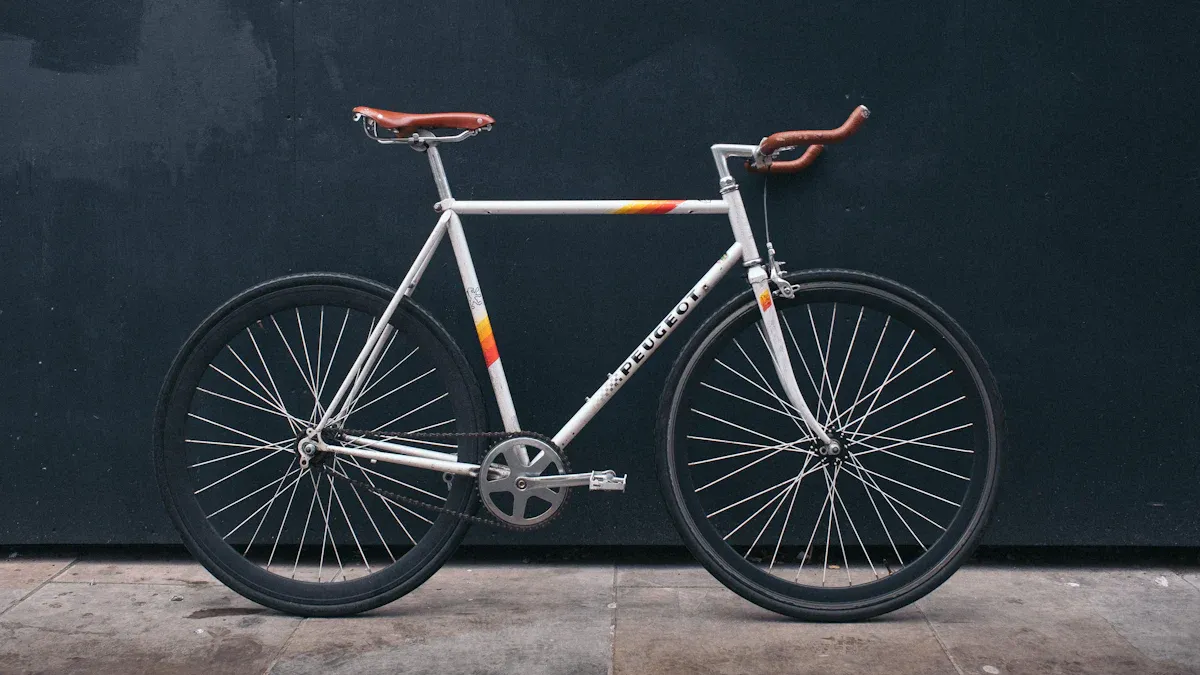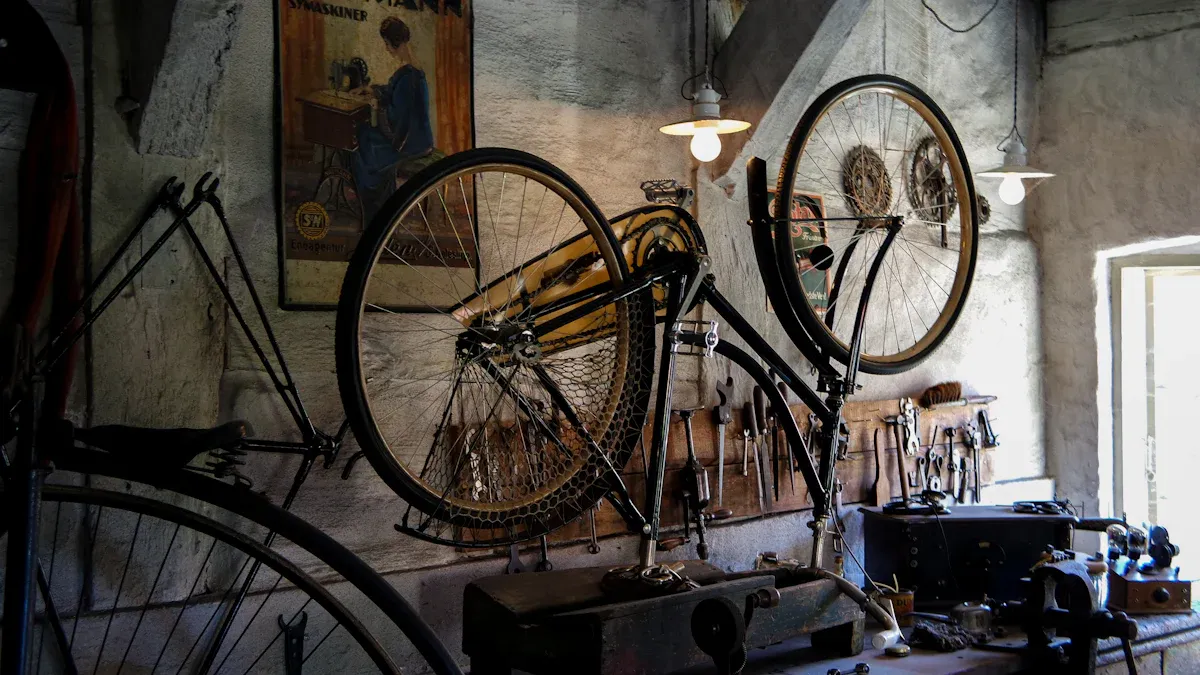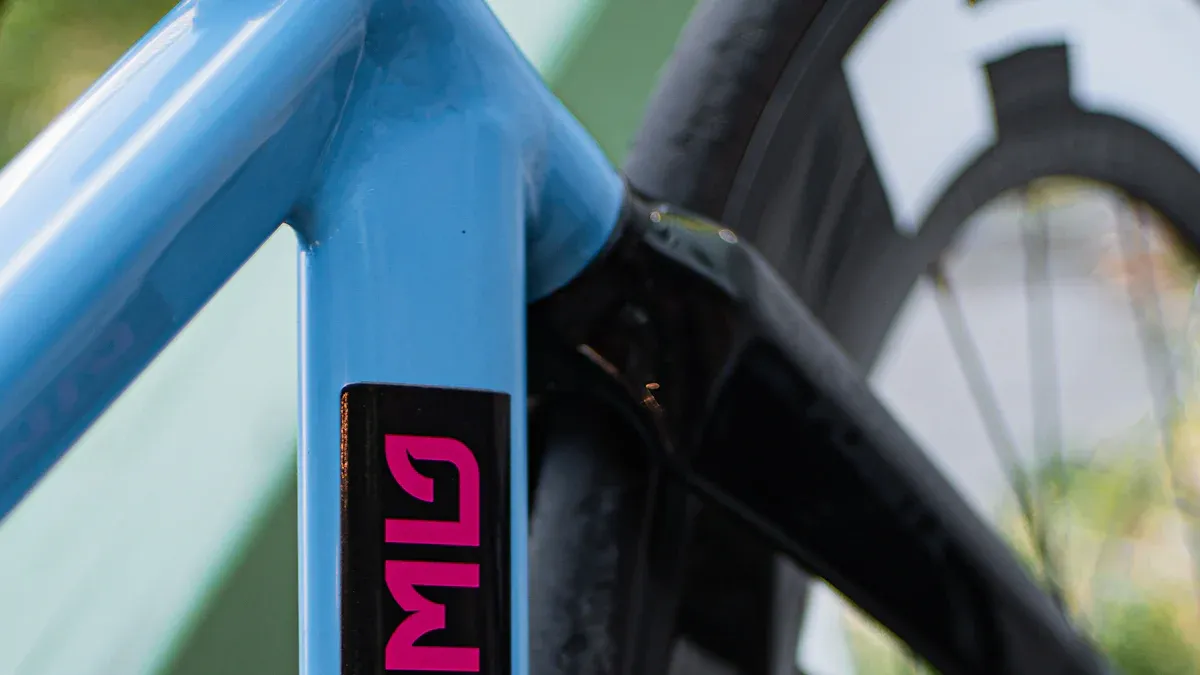
Cyclists like how steel road bike frames mix skill and performance. The steel frame gives a smooth ride and shows tradition. For many years, steel frames have changed cycling history. Many riders are happy that steel is popular again for its strength and look. This comeback proves the steel road bike is still loved. Builders keep improving the steel frame, making it old and new at the same time.
Key Takeaways
Steel road bike frames give a smooth and comfy ride. They soak up bumps better than aluminum and many carbon fiber frames. Modern steel alloys and new ways to build frames make them lighter and stronger. These frames are also more durable but still look classic. Steel frames are simple to fix, so they can last for many years. This makes them a smart pick if you want to use your bike for a long time. Steel frames are heavier than aluminum and carbon fiber frames. But they give better comfort and are tougher for daily riders. Many cyclists and builders like steel for its mix of tradition and strength. They also like the special bond it gives with the bike.
Evolution of Bike Frames

Early Developments
Bike design started with simple bikes made from wood and iron. These first bikes were called “boneshakers.” They were heavy and hard to ride. People wanted better bikes, so they looked for new materials. Steel became the best choice. It was strong and flexible. Steel made bikes smoother to ride. In 1897, Alfred M. Reynolds made butted steel tubing. This made tube ends thicker and the middle thinner. It saved weight and kept bikes strong. The “safety” bicycle used a diamond-shaped steel frame. This changed bike design in a big way.
Key Milestones
Steel became the main material for road bikes. Builders joined tubes using lug brazing and fillet brazing. These ways made frames strong and nice-looking. In 1935, Reynolds made the 531 steel alloy. It was stronger and lighter than older materials. Racers used it to win big races like the Tour de France. During the World Wars, steel tubing was used in military bikes and planes. The main ideas for making steel frames have stayed the same for over 40 years. These early steps still shape how bikes are made today.
Shifts in Materials
New materials for bike frames came later. Aluminum frames showed up in the late 1900s. They were lighter and stiffer. Racers could go faster with them. Carbon fiber came next. It made frames even lighter and stronger. These changes helped bikes get better. But aluminum and carbon fiber had problems. Aluminum could feel rough and wear out fast. Carbon fiber could break if hit hard. Many riders still liked steel. It was comfy, tough, and easy to fix. Today, bikes use steel, aluminum, and carbon fiber. Each material changes how bikes ride and what cycling will be like.
Note: Adventure and gravel cycling made steel frames popular again. This shows old bike frame materials are still important in new bike designs.
Steel Road Bike Frame Innovations

Tubing and Alloys
Steel tubing has changed a lot over time. Early steel road bike frames used simple alloys with thick walls. These frames felt heavy but were strong. New steel alloys like Reynolds 631, 725, and 853 are now used. These alloys go through special heat treatments and can harden in air. Builders can use thinner tubes that are still strong and lighter.
Here is a table that compares popular steel alloys in high-end frames:
Alloy | Key Characteristics | Typical Use in High-End Road Bikes |
|---|---|---|
Reynolds 631 | Modern air-hardening steel, easier and stronger welding, durable and long-lasting | Touring and long-distance riding frames |
Reynolds 725 | Heat-treated chrome-molybdenum alloy, higher strength than non-heat-treated steels | Performance road and cyclocross bikes |
Reynolds 853 | Air-hardening steel that gains strength after welding, lightweight, very stiff | High-end road, mountain, and cyclocross racing |
Reynolds 953 | Premium stainless steel, very high tensile strength, excellent corrosion resistance | Top-tier custom frames (no longer sold due to supply issues) |
Modern steel tubing is bigger around and has thinner walls. This makes frames stiff and light. For example, a frame made with Reynolds 953 can weigh almost two pounds less than an old frame with Reynolds 531. Old and new steel tubing have about the same density and stiffness. But new alloys are stronger and resist rust better. Builders often pick butted steel tubing for most steel road bike frames. This tubing has thick ends and thin centers. It saves weight and keeps the frame strong.
Modern steel tubing is wider and has thin walls for lighter frames.
Strong alloys like chromoly and stainless steel make frames last longer and weigh less.
Butted steel tubing is still important for both old and new frames.
Construction Techniques
Steel frame building has changed as bikes have changed. Builders used to make frames with lugs. Lugs are special pieces that connect the tube ends. Brazing joins the tubes with silver or brass at lower heat. This keeps the steel strong and spreads out stress. Lugged frames look classic and are good for custom bikes.
Welded steel frames use TIG welding. This method melts the steel at the joint to join the tubes. TIG welding lets builders make many frame shapes and work faster. New alloys like Reynolds 853 get stronger from the heat of welding. Welded frames look smooth and modern.
Here is a table that compares lugged and welded steel construction:
Aspect | Lugged Steel Frame Construction | Welded Steel Frame Construction |
|---|---|---|
Joining Method | Uses lugs and brazing | Uses TIG welding |
Temperature Impact | Lower temperatures, preserves tubing strength | Higher temperatures, modern alloys tolerate heat |
Geometry Flexibility | Limited by lug shapes | Flexible, allows custom shapes |
Production Speed | Slower, more cleanup | Faster, cost-efficient |
Aesthetic | Classic, traditional | Modern, clean welds |
Some builders use fillet brazing, which makes smooth joints without lugs. This takes more time but allows cool frame shapes. New tools like CNC machines and careful tube fitting help frames line up right and stay strong. Special coatings protect steel from rust, so frames last longer.
Modern Features
Modern steel road bike frames have features for today’s riders. Many frames now fit wide tires, up to 700x35mm. This helps with adventure and gravel riding. Hidden cable routing makes bikes look neat and keeps cables clean. Some frames only hide cables in the fork, which makes fixing things easier.
Flat mount disc brakes and thru-axles are common on new steel frames. These features help bikes stop better and keep wheels safe. Builders make frames that work with wireless, Di2, or regular drivetrains. Riders can pick the setup they like best.
Tip: New steel tubing and building methods help frames soak up bumps. This makes rides more comfortable and helps riders feel less tired.
Steel road bike frames are good for racers and people who ride for fun. Builders use steel tubing to make frames that can take hits and last a long time. Steel frames soak up shocks and bumps, so rides feel smooth. Steel frames are heavier than aluminum or carbon fiber, but they are tough and easy to fix. Bike design changes and new steel ideas keep steel frames popular with many riders.
Ride Quality and Durability
Comfort and Feel
Steel road bike frames are known for a smooth ride. Many riders feel that steel helps soften bumps and shakes. Steel bends a little when you hit rough roads. This makes the ride less harsh and more comfy. Aluminum frames do not absorb bumps as well. They send more vibration to the rider. Carbon fiber frames can also reduce bumps, but it depends on how they are made. Cyclists say comfort is very important, almost as much as saddle design. The way steel tubes are made changes how the bike feels. Builders can change tube thickness to make rides easier on long trips.
Note: Comfort comes from more than just the frame. Handlebars, forks, and wheels also help stop vibrations from reaching you.
Repairability
Steel frames are easy to fix if they break. Skilled builders can weld or braze cracks and dents. This works well because steel is simple to shape and join. Aluminum frames are harder to fix and often need to be replaced. Carbon fiber frames need special repairs from experts. Checking your bike often helps find problems early. Steel’s easy repairs make it a smart pick for people who want a long-lasting frame. Many riders choose steel because it is strong and simple to repair.
Steel frames: Weld or braze to fix damage
Aluminum frames: Often must be replaced
Carbon fiber frames: Need expert composite repair
Longevity
Steel road bike frames last a very long time. If you take care of them, they can last for decades. Chromoly steel frames also last many years. Rust can hurt steel, but most rust can be fixed. Experts say steel frames almost never become useless, even after many years. Aluminum and carbon fiber frames usually last 5 to 10 years. Steel frames often last over 20 years. Titanium frames can last a lifetime, but steel is still loved for its strength and easy repairs.
Frame Material | Average Lifespan |
|---|---|
Steel | |
Titanium | Lifetime |
Carbon Fiber | 5-10 years |
Aluminum | 5-10 years |
Chromoly (Steel) | 20+ years |
Steel frames are tough and can handle rough use for many years. Some riders even pass down steel frames to family, showing how long they last.
Steel vs. Other Materials
Weight and Performance
The material of a bike frame affects how it rides. Steel frames, especially chromoly steel, are heavier than aluminum and carbon fiber. Most steel frames weigh from 3 to 5 pounds. Newer strong steel can be about 3 pounds. Old steel frames can weigh up to 5 pounds. Aluminum frames usually weigh 3 to 4 pounds. Carbon fiber frames are the lightest at about 2 pounds.
Material | Typical Weight Range (lbs) | Notes |
|---|---|---|
Carbon Fiber | ~2 – 2.5 | High-end carbon frames can weigh as little as 2 lbs. |
Steel | 3 – 5 | Modern high strength steel alloys typically 3-4 lbs; lower-end steel can be up to 5 lbs |
Aluminum | 3 – 4 | Generally lighter than steel but heavier than carbon; varies with tube thickness |
Steel frames last a long time and soak up bumps well. This makes rides smooth and comfy. Aluminum frames are lighter and stiffer. They help you go fast but can feel rough. Carbon fiber frames are the lightest and stiffest. Builders can make them stiff or bendy in some spots. Steel is not as light or stiff as the others. But it is strong and comfy to ride.
Tip: If you want to race, carbon fiber is best. If you want comfort and strength, steel is a good pick.
Cost and Value
The frame material changes how much a bike costs and how long it lasts. Steel frames are cheaper to make than most other frames. This makes steel a smart choice for people who want a strong bike that is easy to fix. Aluminum frames cost more to make but are quick to build. Titanium and carbon fiber frames cost the most. They need special tools and take more time to build.
Steel frames are strong and last many years. They soak up bumps and can handle heavy loads. Steel bends slowly instead of snapping, so it is safer. You can fix steel frames easily, which makes them worth more. Steel needs care to stop rust, especially in wet places. Many people pick steel for city bikes, touring, and cargo bikes because it is tough and comfy.
Steel frames: Cheap, strong, easy to fix
Aluminum frames: Cost more, quick to make, very stiff
Carbon fiber frames: Most expensive, lightest, best for racing
Titanium frames: Very costly, last a lifetime
The frame material changes how much you pay and how your bike feels. Steel frames are known for being strong and lasting a long time.
Real-World Experiences
Enthusiast Stories
People who love cycling pick steel road bike frames for many reasons. They often say these bikes feel special and last a long time. Many riders think steel frames give a bouncy and lively ride. This helps make long rides easier and less tiring. Some riders, like Natalia Gardiol, choose steel for its story and the feeling it gives. She feels close to her bike, not just for racing. She likes the skill and personal meaning in her choice.
Recreational cyclists like Stefan Scott use steel for daily rides. He rides on rough city roads and in bad weather. He trusts steel because it is strong and comfy. Riders like Stefan like how steel frames handle hard rides and last many years.
Many fans say these are the main reasons they pick steel:
Feels smooth, even on bumpy roads
Easy to fix if it breaks
Looks classic and never goes out of style
Chromoly steel is strong and bends a little
Steel frames are popular again because racers and everyday riders like these things. Each group finds something special in how steel bikes ride and look.
Frame Builder Insights
Bike builders see good and hard things about working with steel. They like steel because it is strong, lasts long, and can be made into custom frames. Builders can shape steel into many sizes and styles, so each bike is different. They also say steel keeps away bugs and can last a long time if cared for.
Advantages | Challenges |
|---|---|
Strong and lasts long | Needs extra layers for heat |
Can be made to fit any rider | Must be made very carefully |
Safe from fire and bugs | May need more coatings to protect it |
Can be treated to stop rust | Harder to change after building |
Modern builders use new tools and ways to build. For example, Will Scharen uses 3D printing to make steel fork crowns. He mixes old hand work with new machines. This helps builders make bikes for today’s riders but keeps the classic steel feel. Many builders care about small details and quality, so each frame is like a piece of art.
Steel road bike frames are known for being comfy and strong. They also have a classic style that many people like. Riders enjoy how smooth these bikes feel on the road. Steel frames can be fixed easily, so bikes last a long time. Builders work hard to make steel frames lighter and tougher. As bike technology gets better, steel frames may get smart features and green designs. Steel keeps inspiring riders and builders. It shows that old ways and new ideas can help cycling get better.
FAQ
What makes steel road bike frames different from aluminum and carbon fiber?
Steel frames offer a smooth ride and strong build. Aluminum frames feel lighter but can be stiff. Carbon fiber frames weigh less and can be shaped for speed. Each material changes how the bike feels on the road.
How can someone prevent rust on a steel bike frame?
Riders keep steel frames dry and clean. They use frame protectants or wax. Regular checks for scratches help stop rust from starting. Many modern steel frames use coatings that resist rust.
Are steel road bike frames good for long-distance rides?
Steel frames work well for long trips. They absorb bumps and reduce fatigue. Many touring cyclists choose steel for comfort and reliability. The frame’s strength helps carry gear over many miles.
Can a steel frame be repaired if it gets damaged?
Bike shops fix steel frames with welding or brazing. Steel’s structure allows easy repairs. Riders often choose steel because it can be restored after accidents or heavy use.
How heavy is a typical steel road bike frame?
Most steel road bike frames weigh between 3 and 5 pounds. Newer steel alloys make frames lighter. The weight depends on the type of steel and the frame design.
See Also
Evolution Of Single Gear Bike Frames From Iron To Carbon
Key Features That Make Titanium Bike Frames Unique
Exploring The Innovations Powering Carbon Fiber Bike Frames
